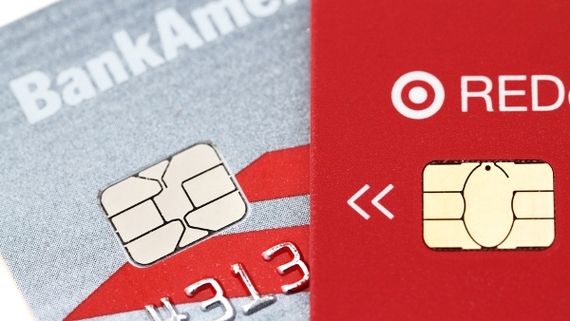October 1st was supposed to be a transition day for U.S. businesses with respect to credit cards. With a few exceptions like autopay gas pumps, credit card transactions were scheduled to be switched to the EMV method of payment processing.
However, many retailers did not meet the October 1st deadline, and some have no intention of changing. That means that for a few years, your credit card may be used in several different ways depending on the vendor, and that in turn could affect the security of your account.
Here's what you need to know about the EMV technology and how it will be used during the transition.
EMV is short for Europay, MasterCard, Visa, the group that collectively established the standards and specifications for this method. It is also known as the "chip-and-PIN" method, since the credit cards have a computer chip embedded within the card. The chip shows up as a metallic square located toward one end of the card. You will be receiving a new EMV card soon if you haven't already, especially if you are using one of the major credit card companies. If not, request one as soon as possible.
EMV cards improve security because the chip transfers information that is only valid for that transaction. It is pointless for thieves to steal the data because it cannot be used for any other transactions. In a normal swipe, your basic card information is transferred, exposing it to theft and fraudulent secondary use.
New readers contain a small rectangular slot at the base for you to insert the card. The reader holds the card for a few seconds while information is transferred, and then notifies you to remove your card after the process is complete. Do not pull the card out early before the transaction is complete, or forget and leave the card in the reader. (That sounds insultingly obvious, but it does happen.)
Chip-and-PIN cards will work with either a traditional swipe or a card slot, and new readers contain both technologies. However, if you use a chip-and-PIN card in the traditional magnetic stripe reader, your card number is being transferred and the process is no more secure than it was before.
If you are not sure what method to use at any reader, ask the clerk. If the clerk does not know either (that does happen sometimes), try swiping the magnetic strip first. If the chip reader is enabled, the display may instruct you to use the chip reader instead of the magnetic strip reader.
It is estimated that a bit less than 30% of retailers were ready to accept chip-bearing cards at the deadline, and it may take until 2017 to reach 90% compliance. Retailers who do not install the new technology bear responsibility for fraudulent transactions, but it can cost up to $600 per reader to buy and install the new technology -- so some smaller retailers that do not sell big-ticket items prefer to skip the expenses and take their chances.
Note that chip-and-PIN technology only prevents one form of fraud -- the "card present" fraud from data theft at point of sale. You take the same risks as before by using your credit card number online.
Another confusing aspect: cards with embedded chips do not necessarily have assigned PINs, and readers may not ask for the PIN even though you have one. Many American banks are simply sticking with the chip-and-sign, relying on the embedded chip as the single security mechanism. If that type of card is stolen, the lack of a PIN means that others can easily use your card for transactions. Make sure you read the instructions with your new card and understand what kind you have and how to use it -- and if you prefer that a PIN be included, demand that from your card issuer or find another one.
Don't lose that PIN! Eventually you will need the PIN with more security-conscious retailers, and if you haven't used it repeatedly as you do with a debit card, you are likely to forget it when you need it the most. In addition, you will likely need the full chip-and-PIN arrangement to use your card overseas.
For the next few years, take a few extra precautions at checkout counters and use the most secure method that is available to you. If you can decrease your odds of having your credit card information compromised, why wouldn't you do so?
Photo ©iStock.com/NoDerog
